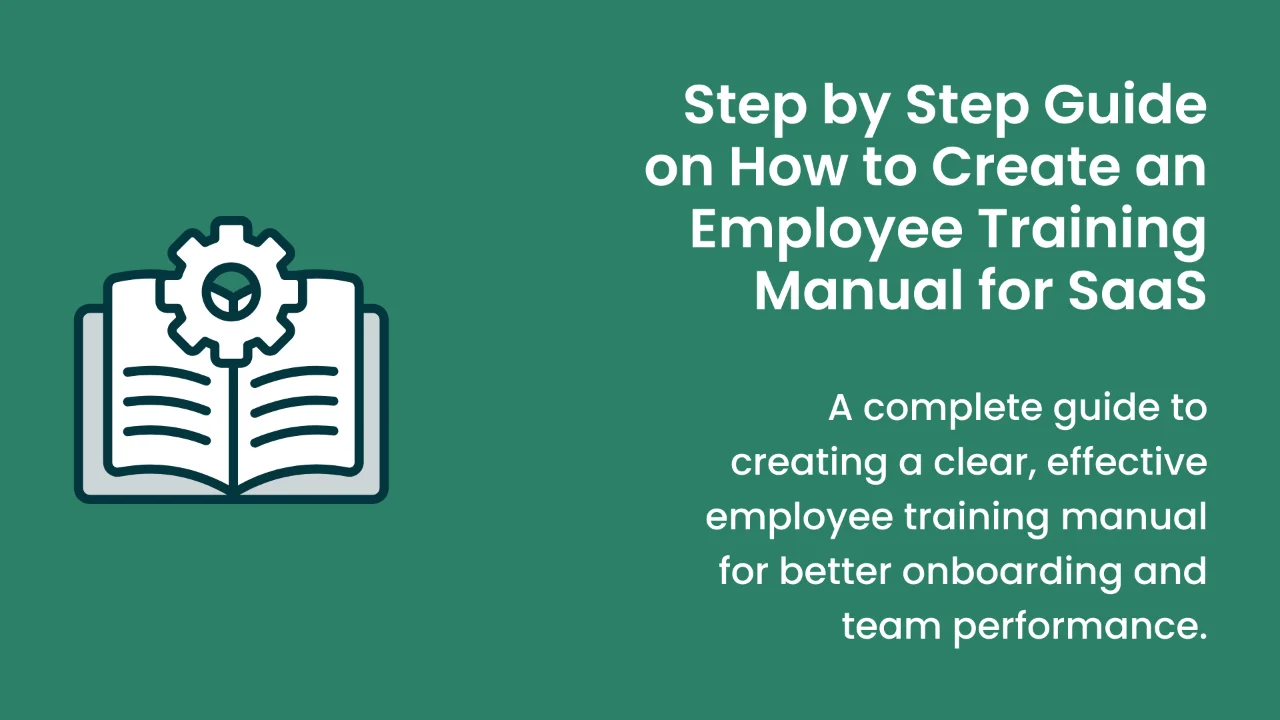Have you ever carried out a competitive analysis for your company or business? What elements did you use to carry out the analysis? How do you evaluate your place in the market?
If you want your business to grow, it is vital to evaluate your competitors - to see what they are doing and what you need to do.
Competitor analysis will shift you from your comfort zone so that you can do better. The analysis should be done often to fill the gaps that might have been created over the period.

In this article, we will cover what competitor analysis is, how to conduct it, and its importance.
What Is Competitor Analysis?
Competitor analysis is doing background research on your major competitors to learn more about their marketing, products, sales, and unique selling points.
You need to have a list of competitors with who you share a niche and start researching how the company or business has been fairing for a couple of months or years. What makes them stand out?
A competitor analysis will open your eyes to see better strategies you can implement and the gaps being left out by your competitors that you can fill out.
The analysis should be broad enough to capture potential opportunities you can leverage in the specific niche. A competitor analysis can help your company identify market gaps, develop new products or services, learn market trends, identify a better target audience, and sell more effectively.
Why Is Competitive Analysis Important?
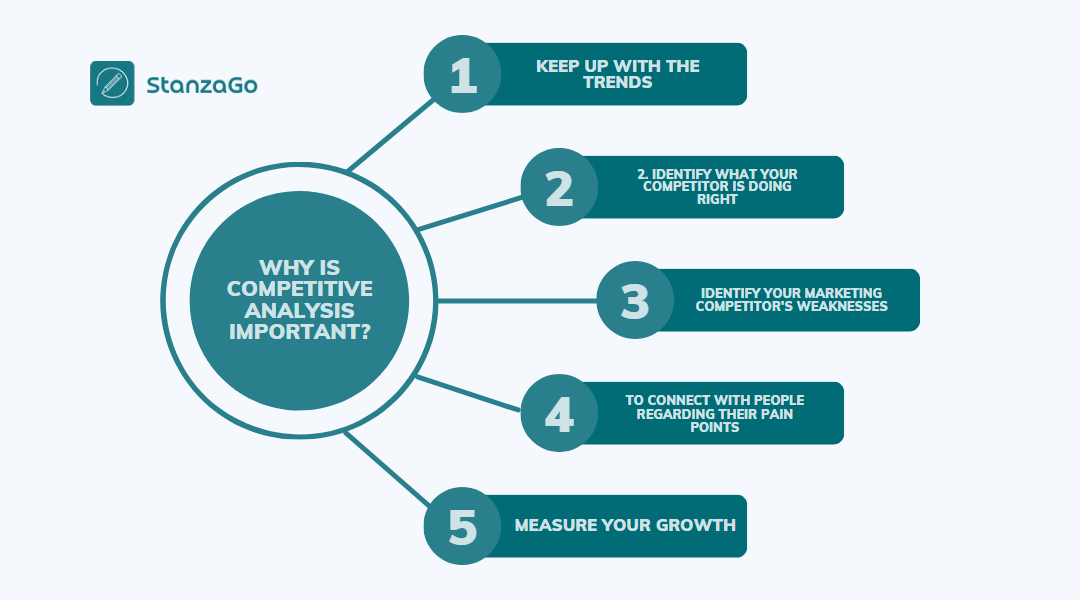
1. Keep Up With the Trends
A competitive analysis makes it easy to keep up with the trends. If your competitor used to implement certain strategies and stopped, you should shift from that too. This is to ensure your services and products reach exemplary industrial standards.
It also makes it easier to know your unique selling point and how to boost it. Therefore, future marketing efforts will be more customized.
2. Identify What Your Competitor Is Doing Right
The competition analysis also makes it easier to discover what your competitors are doing and what you aren't.
- Is there a marketing strategy they are using that is bearing fruit?
- What marketing strategies have they stopped using that you are still using?
Also, research all marketing campaigns that can boost your products and services. For example, digital marketing, influencer marketing, social media marketing, email marketing, content marketing, and much more.
3. Identify Your Marketing Competitor's Weaknesses
Through competitive analysis, it becomes easier to identify the competitor's weaknesses. You can check where they fall short and use that as your strength. Also, try and review their strengths and work towards being better than them.
4. To Connect With People Regarding Their Pain Points
Reviews and feedback play a significant role in educating companies on where to catch up. People are always genuine when satisfied or dissatisfied with a specific product or service.
5. Measure Your Growth
Competitive analysis is a great way to measure your growth. You can evaluate where your company stands among the rest. How far have you come?
Are there some businesses in which you were on the same page and then overlapped, or have you overlapped them? It would be great news if you realized you are among the best.
How to Conduct a Competitive Analysis?
There are 8 steps you can take when conducting a competitive analysis:

Step 1: Determine Your Competitors
When carrying out your competition analysis in marketing, it is important to determine all your competitors. Which are the other companies dealing with the same products or services in your area or globally?
First, divide your competitors into direct and indirect competitors.
- Direct competitors are the companies that offer similar products and services as you. They may be operating in your area or globally.
- The indirect competitors are the ones who are not selling different products and services but could satisfy the same need that you satisfy. They are equally important as the direct competitors.
The indirect competitors may even be implementing strategies like online shopping and delivery that your business doesn't.
People will prefer convenience from the company than having to walk in into your store. Write down all the competitors' details so you can research them individually. Identifying competitors will make it easier to know the parameters to evaluate them with.
Step 2: Check the Products and Services Offered by Your Competitors
No business can be 100% similar to the other. Therefore, you need to check the products and services the company or business offers.
What brands are they collaborating with? Is that what makes them stand out? While on this step, analyze the kind of product quality that they offer. Are they working with multinational companies or local companies? Might that be the reason they get more customers?
You can check whether they offer wholesale services, their product providers, the needs of their customers, their market share, pricing strategies, and how they distribute products.
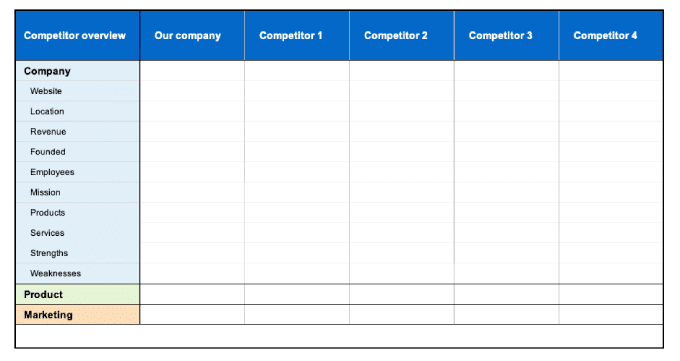
This may seem simple, but it can be a game-changer. For example, if they offer online delivery, more people will want such convenience rather than having to get the products themselves with their busy schedules.
If you have a restaurant, why not also offer office or home delivery services? Some workers may not have long lunch breaks and ordering online can save them time.
Step 3: Check Their Marketing Strategies
It is essential to check how your competitors market their products and services.
Do they brand their packaging? Could it be that through their packaging they capture more customers' attention who come across the packaging?
Also, check the marketing channels that they use.
- Do they post on social media?
- Do they have a blog that shows how to use certain products and services?
- How often do they offer discounts, offers, and vouchers?
- How operational and efficient are they?
- Are they just based in one location or multiple locations?
Also, check their frequency of bringing new products to the market, expansion strategies, partner reselling programs, and revenue streams.
If possible, you can check the kind of sales they make per year and profit off-late if they bring that to the limelight. Luckily, some businesses often share their annual reports online.
Step 4: Evaluate the Competitor’s Pricing
It is crucial to check the competitor's products and services prices.
- Do they overprice or provide the right market price?
- Even if they overprice, do they still make sales?
- And if yes, then why is it so?
People sometimes prefer buying expensive items with the notion that they have better quality than the cheaper ones.
Therefore, if you have been selling items at subsidized prices, you can consider increasing them and see whether it can change your customer's purchase power. However, ensure the product is worth the price to prevent losing customers.
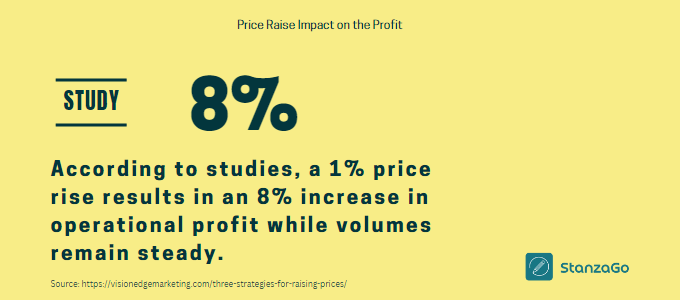
Also, check whether your competitor allows affiliates or has referral programs. How is the competitor's reward system?
While on that, also check the shipping costs your competitor offers. At times if you have expensive shipping costs, people may abandon the cart. Therefore, try and be reasonable. You can opt for free shipping but increase the price of the item to be inclusive of the shipping or delivery costs.
However, you need to provide reasonable prices.
Step 5: Check Competitive Analysis in Marketing
Marketing is crucial if you want your company to succeed. Therefore, check how your competitor markets their products.
- Do they have active social media accounts?
- Do they have how-to videos?
- Do they use an influencer?
- Do they have videos that show how to use the products or get certain services?
- How appealing is their website or app?
- How much investment do they put into marketing?
Furthermore, check for ways in which they engage with their customers and whether they have frequent press releases when they introduce a new product in the market.
Step 6: Check the Content They Offer
Content is key if you want your website to be easily visible.
Thus, check whether they offer insights on various things about the specific niche. For example, if they sell dog food, do they have a blog that gives insights on dog feeding? Food to give at a certain dog age? Etc.
The content needs to be relevant.
Also, check how often they post content, is it often or once a month? Furthermore, check the quality of the content to see what you are doing wrong in your blog that is making you not stand out from the competitors.

Check the content's accuracy, quality, depth, tone, spelling, grammar, structure, number of authors, paid or free content, and any other relevant details. What kind of images do they use: illustrations, customized images, or just generic photos?
How often do they get comments on their blog posts and even respond to queries? How do they link their content with social media?
Step 7: Evaluate Your Competitor’s Social Media Presence
In this time and age, businesses ought to have social media accounts. If yes, how do they engage with their audience?
Also, remember to check whether they have share buttons in their articles or their products and services. The call-to-action buttons need to be strategically placed to make them easier to click.
Different social media platforms can boost unique businesses.
So check which one is the most used by your competitors. The different social media platforms include Facebook, Twitter, Instagram, Snapchat, TikTok, LinkedIn, YouTube, and Pinterest.
You can also check their followers, posting frequency, and content engagement.
Additionally, check the technologies that your competitors use often. What makes them stand out? It is also crucial to check the kind of software your competitors use to ease their selling of products and services.
At times technologies can help in automation that can boost your products and services sales.
Step 8: Perform a Swot Analysis
It is also crucial to perform a SWOT analysis to check the Strengths, Weaknesses, Opportunities, and Threats of your competitor.
Just do a simplified SWOT analysis to see what they are doing well and what they aren't.
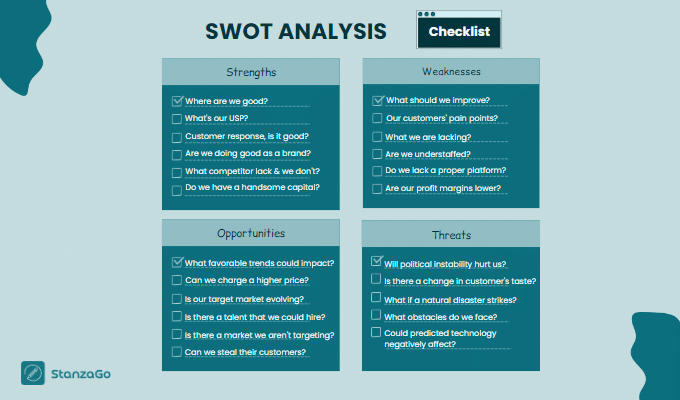
How can you leverage their weaknesses to ensure you stand out from them? Also, check how your brand can take advantage of competitors' downfalls. Are there any opportunities that you can grasp? This will make it easier to work on your business strategy.
What’s Next After You Carry Out the Competitor’s Market Analysis?
After conducting the analysis, document all your findings in a written analysis.
This will make it easier to understand the information you got. You can use visuals like graphs, infographics, and much more.
Through reading the documentation, your business team will be in a better position to learn how to improve the business. Also, remember to limit the competitors to around 10-12 to ensure your focus is on point to get the right results.
And if you need help with product quality and unique content, you can reach out to us anytime. We’ll be more than happy to assist you to take your brand to a new height.



